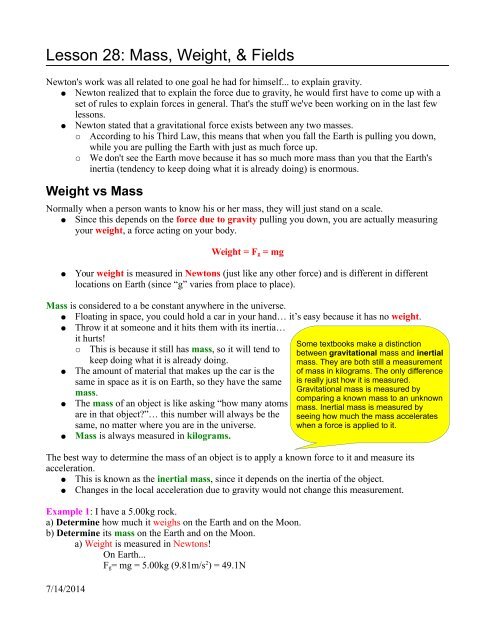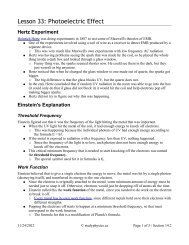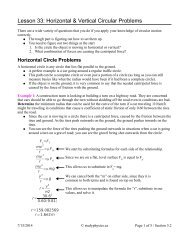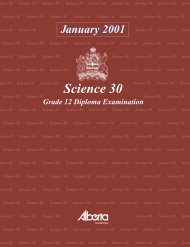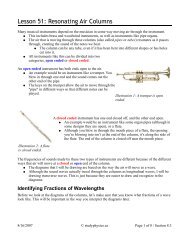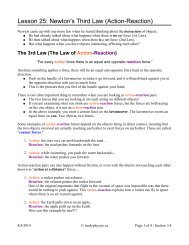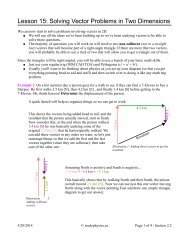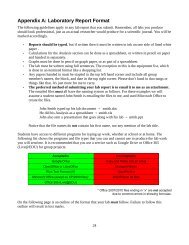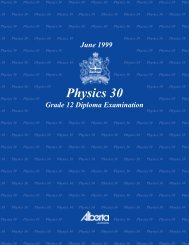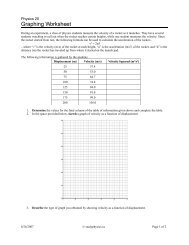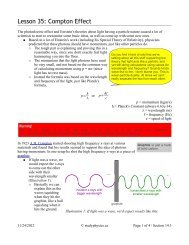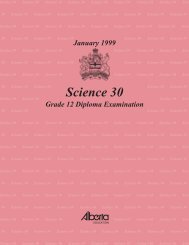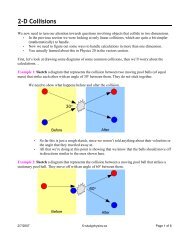Lesson 28: Mass, Weight, & Fields
Lesson 28: Mass, Weight, & Fields
Lesson 28: Mass, Weight, & Fields
Create successful ePaper yourself
Turn your PDF publications into a flip-book with our unique Google optimized e-Paper software.
<strong>Lesson</strong> <strong>28</strong>: <strong>Mass</strong>, <strong>Weight</strong>, & <strong>Fields</strong>Newton's work was all related to one goal he had for himself... to explain gravity.● Newton realized that to explain the force due to gravity, he would first have to come up with aset of rules to explain forces in general. That's the stuff we've been working on in the last fewlessons.● Newton stated that a gravitational force exists between any two masses.○ According to his Third Law, this means that when you fall the Earth is pulling you down,while you are pulling the Earth with just as much force up.○ We don't see the Earth move because it has so much more mass than you that the Earth'sinertia (tendency to keep doing what it is already doing) is enormous.<strong>Weight</strong> vs <strong>Mass</strong>Normally when a person wants to know his or her mass, they will just stand on a scale.● Since this depends on the force due to gravity pulling you down, you are actually measuringyour weight, a force acting on your body.<strong>Weight</strong> = F g = mg●Your weight is measured in Newtons (just like any other force) and is different in differentlocations on Earth (since “g” varies from place to place).<strong>Mass</strong> is considered to a be constant anywhere in the universe.● Floating in space, you could hold a car in your hand… it’s easy because it has no weight.● Throw it at someone and it hits them with its inertia…●●●it hurts!○ This is because it still has mass, so it will tend tokeep doing what it is already doing.The amount of material that makes up the car is thesame in space as it is on Earth, so they have the samemass.The mass of an object is like asking “how many atomsare in that object?”… this number will always be thesame, no matter where you are in the universe.<strong>Mass</strong> is always measured in kilograms.The best way to determine the mass of an object is to apply a known force to it and measure itsacceleration.● This is known as the inertial mass, since it depends on the inertia of the object.● Changes in the local acceleration due to gravity would not change this measurement.Example 1: I have a 5.00kg rock.a) Determine how much it weighs on the Earth and on the Moon.b) Determine its mass on the Earth and on the Moon.a) <strong>Weight</strong> is measured in Newtons!On Earth...F g = mg = 5.00kg (9.81m/s 2 ) = 49.1N7/14/2014Some textbooks make a distinctionbetween gravitational mass and inertialmass. They are both still a measurementof mass in kilograms. The only differenceis really just how it is measured.Gravitational mass is measured bycomparing a known mass to an unknownmass. Inertial mass is measured byseeing how much the mass accelerateswhen a force is applied to it.
On the Moon...F g = mg = 5.00kg (1.67m/s 2 ) = 8.35Nb) The mass of the object on the Earth and the moon is 5.00kg! The object has the same mattermaking it up even if I take it to a different place.Example 2: An object is accelerated at 3.24m/s 2 by a 68.0 N force. Determine its inertial mass.F=mam= F a = 68.03.24 =20.98765=21.0kgGravitational <strong>Fields</strong>Did You Know?Newton realized that the gravity that keeps you on the Earth is the same The idea of “fields” is also usedgravity that keeps the moon in its orbit around the Earth.in Social Studies classes. The● To explain this action-at-a-distance force, physicists often use difference is that they call it athe idea of fields.“Sphere of Influence.” Forexample, the former USSR had● A field is an area around an object that has an effect on nearbya sphere of influence thatobjects.extended outwards to many● In the case of gravitational fields, the field always points in nations that were nearby.towards the centre of the mass.● All masses have a gravitational field, but only the gravitational fields of large objects (likeplanets) are easily noticeable.To measure and show the gravitational field around anobject, we would place a known test mass nearby.● The test mass is any mass we choose, as long as it issmall enough that it does not have a significantgravitational field of its own (theoretically its mass1should be kg , which is so close to zero that it∞doesn't even really matter).● The test mass will always move towards the centreof the object, so we draw vectors pointing intowards the centre.● By measuring the force of gravity pulling the testmass towards the object, we have a measurement ofthe gravitational field near the object.g= F gmRiceKrispiesIllustration 1: Although weak, there is agravitational field around a cereal box.You'll notice that we are actually measuring the acceleration due to gravity at that location.● We could certainly measure it in m/s 2 , or we can choose to use units that have more to do withthe experiment we just did, N/kg .● On many data sheets you'll see that the acceleration due to gravity is also listed as agravitational field strength.7/14/2014
○You'll probably see the value listed near Earth's surface as 9.81 m/s 2 and 9.81 N/kg. The twoideas are used pretty interchangeably in most questions.It is also reasonable to say that the effect of gravity is greatest when closer to the object.● As you move further and further away from the centre, the force exerted by gravity becomesweaker (although it never truly disappears).● Illustration 1 shows this by the way the vectors are further apart from each other when moredistant from the object. Closer in the vectors are closer to each other.○ This means the gravitational field is stronger when gravitational field vectors are drawncloser.● As a relationship, this is shown by...g= 1 r 2●This inverse square relationship became the basis of one of Newton's greatest formulas, theLaw of Universal Gravitation.Homeworkp202 #1,2,4,5,7,97/14/2014


